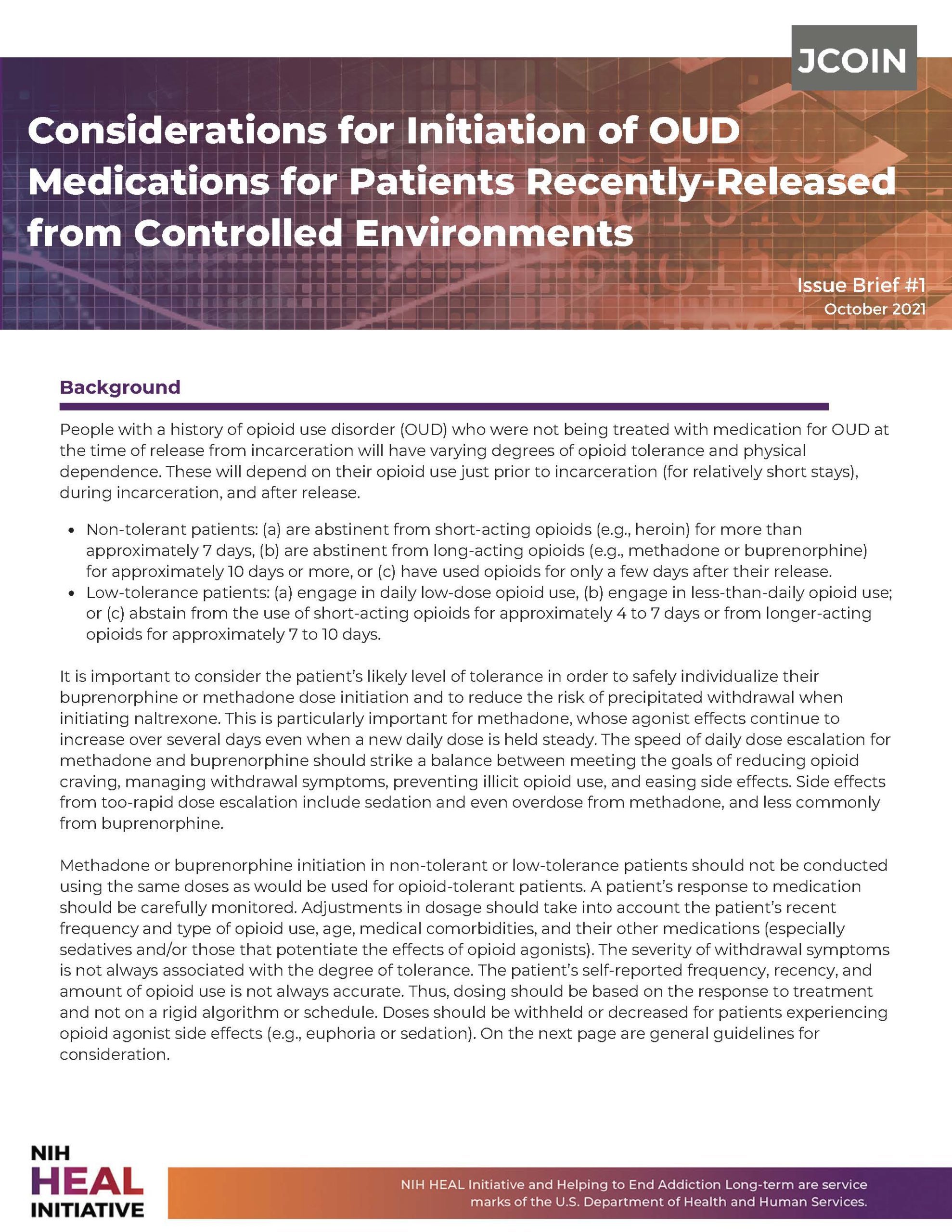Issue Brief: Considerations for Initiation of OUD Medications for Patients Recently Released from Controlled Environments
Background
People with a history of opioid use disorder (OUD) who were not being treated with medication for OUD at the time of release from incarceration will have varying degrees of opioid tolerance and physical dependence. These will depend on their opioid use just prior to incarceration (for relatively short stays), during incarceration, and after release.
- Non-tolerant patients: (a) are abstinent from short-acting opioids (e.g., heroin) for more than approximately 7 days, (b) are abstinent from long-acting opioids (e.g., methadone or buprenorphine) for approximately 10 days or more, or (c) have used opioids for only a few days after their release.
- Low-tolerance patients: (a) engage in daily low-dose opioid use, (b) engage in less-than-daily opioid use; or (c) abstain from the use of short-acting opioids for approximately 4 to 7 days or from longer-acting opioids for approximately 7 to 10 days.
It is important to consider the patient’s likely level of tolerance in order to safely individualize their buprenorphine or methadone dose initiation and to reduce the risk of precipitated withdrawal when initiating naltrexone. This is particularly important for methadone, whose agonist effects continue to increase over several days even when a new daily dose is held steady. The speed of daily dose escalation for methadone and buprenorphine should strike a balance between meeting the goals of reducing opioid craving, managing withdrawal symptoms, preventing illicit opioid use, and easing side effects. Side effects from too-rapid dose escalation include sedation and even overdose from methadone, and less commonly from buprenorphine.
Methadone or buprenorphine initiation in non-tolerant or low-tolerance patients should not be conducted using the same doses as would be used for opioid-tolerant patients. A patient’s response to medication should be carefully monitored. Adjustments in dosage should take into account the patient’s recent frequency and type of opioid use, age, medical comorbidities, and their other medications (especially sedatives and/or those that potentiate the effects of opioid agonists). The severity of withdrawal symptoms is not always associated with the degree of tolerance. The patient’s self-reported frequency, recency, and amount of opioid use is not always accurate. Thus, dosing should be based on the response to treatment and not on a rigid algorithm or schedule. Doses should be withheld or decreased for patients experiencing opioid agonist side effects (e.g., euphoria or sedation).
Open each accordion below for general guidelines for consideration:
This issue brief was developed by the JCOIN Medications for Opioid Use Disorder Workgroup. JCOIN is funded by the National Institute on Drug Abuse (NIDA) as part of the NIH HEAL Initiative. The contents of this publication are solely the responsibility of the authors and do not necessarily represent the official views of the NIH, the NIH HEAL Initiative, or the participating sites.
Suggested citation: Justice Community Opioid Innovation Network. (2021). Considerations for Initiation of OUD Medications for Patients Recently Released from Controlled Environments [JCOIN Issue Brief #1]. https://www.jcoinctc.org/issue-brief-considerations-for-initiation-of-oud-medications/
